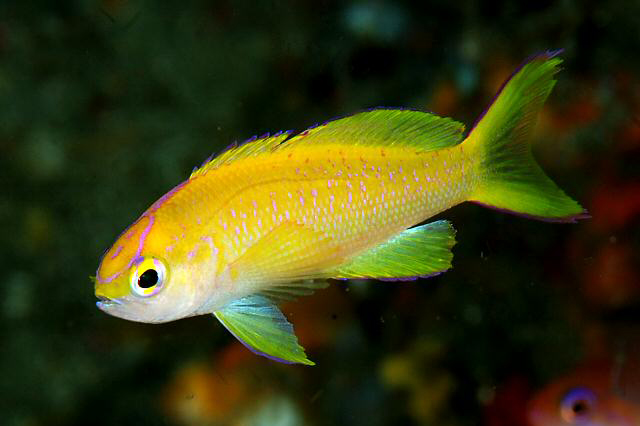- Classification
- ACTINOPTERYGII
- PERCIFORMES
- SERRANIDAE
- Pyronotanthias
- parvirostris
Sunset Anthias, Pyronotanthias parvirostris (Randall & Lubbock 1981)

A Sunset Anthias, Pseudanthias parvirostris, in Izu Ocean Park, Japan. Source: Izuzuki / www.izuzuki.com. License: CC BY Attribution-ShareAlike
Summary:
Males of this small anthias are yellowish on upper third, pink below, with a magenta line between the eyes and from the top of the eye to the dorsal-fin origin, dorsal fin and upper and lower caudal-fin lobes magenta. Females mostly yellow to yellowish-orange with a magenta band between the eyes and from the top of the eye to the dorsal-fin origin.
Rarely seen due its small size and deep-water habitat - usually below 40 m.
This species was previously known as Pseudanthias parvirostris.
Video of Sunset Anthias
Rarely seen due its small size and deep-water habitat - usually below 40 m.
This species was previously known as Pseudanthias parvirostris.
Video of Sunset Anthias
Cite this page as:
Bray, D.J. 2025, Pyronotanthias parvirostris in Fishes of Australia, accessed 27 Jun 2025, https://fishesofaustralia.net.au/Home/species/5025
Sunset Anthias, Pyronotanthias parvirostris (Randall & Lubbock 1981)
More Info
|
Distribution |
Occurs at Rowley Shoals, Western Australia, and on Flora Reef in the Coral Sea Marine Park, Australia. Elsewhere, the species is widespread in the Indo-West Pacific from Mauritius (Mascarenes), Indonesia east to Palau, north to southern Japan, south to Western Australia and the Coral Sea, and the Solomon Islands. Inhabits outer reef slopes in depths of 35-65 m, usually below 40 m. Forms small groups above patch reefs on sandy or rubble slopes. |
|
Features |
Dorsal fin X, 15-16; Anal fin III, 7; Pectoral fin 17; Lateral line scales 41-44; Gill rakers 8-11 + 22-24. Male with a fleshy protuberance on snout in front of upper lip; pelvic fins reaching just beyond anal-fin spines in male; caudal fin lunate with short filamentous tips in male. |
|
Biology |
A protogynous hermaphrodite. Forms small harems with a dominant male and a small group of females. If the male disappears, the highest-ranking female will change sex and colour over a couple of weeks to assume control of the harem. |
|
Species Citation |
Anthias (Mirolabrichthys) parvirostris Randall & Lubbock 1981, Contributions in Science (Los Angeles) 333: 6, fig. 2. Type locality: Outer reef slope on western side, Alite Reef, off Malaita, Solomon Islands, western Pacific, depth 60 meters. |
|
Author |
Bray, D.J. 2025 |
|
Resources |
Sunset Anthias, Pyronotanthias parvirostris (Randall & Lubbock 1981)
References
Allen, G.R. & Adrim, M. 2003. Coral reef fishes of Indonesia. Zoological Studies 42(1): 1-72.
Allen, G.R. & Erdmann, M.V. 2012. Reef fishes of the East Indies. Perth : Tropical Reef Research 3 vols, 1260 pp.
Gill, A.C. 2022. Revised definitions of the anthiadine fish genera Mirolabrichthys Herre and Nemanthias Smith, with description of a new genus (Teleostei: Serranidae). Zootaxa 5092(1): 41-66. https://doi.org/10.11646/zootaxa.5092.1.2
Heemstra, P.C. & Randall, J.E. 1999. Family Serranidae. pp. 2442-2548 in Carpenter, K.E. & Niem, T.H. (eds). The Living Marine Resources of the Western Central Pacific. FAO Species Identification Guide for Fisheries Purposes. Rome : FAO Vol. 4 2069-2790 pp.
Myers, R.F. 1999. Micronesian Reef Fishes. A comprehensive guide to the coral reef fishes of Micronesia. Guam : Coral Graphics vi 330 pp. 192 pls.
Randall, J.E. 2011. Two new serranid fishes of the genus Pseudanthias from the Western Indian Ocean. Smithiana Bulletin 13: 75-78.
Randall, J.E. & Lubbock, R. 1981. A revision of the serranid fishes of the subgenus Mirolabrichthys (Anthiinae: Anthias), with description of five new species. Contributions in Science (Los Angeles) 333: 1-27.
Randall, J.E. & Pyle, R.L. 2001. Four new serranid fishes of the anthiine genus Pseudanthias from the South Pacific. Raffles Bulletin of Zoology 49(1): 19-34. See ref online

